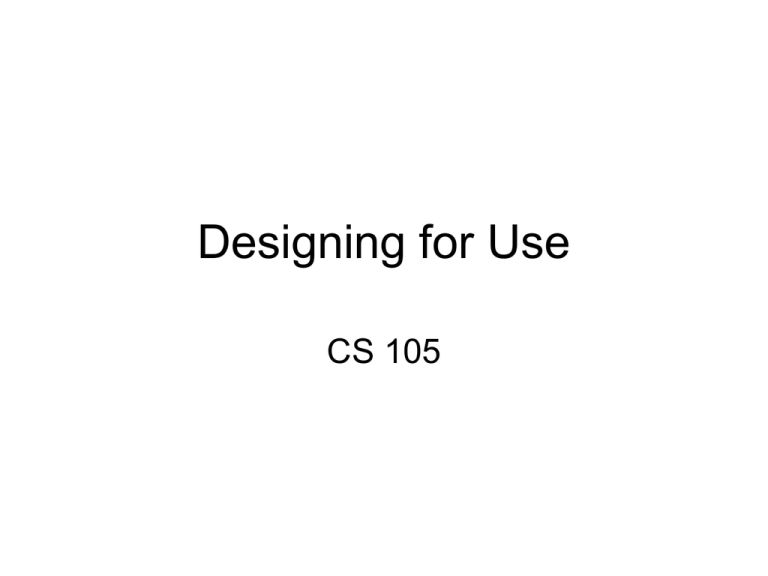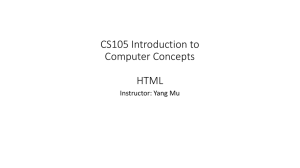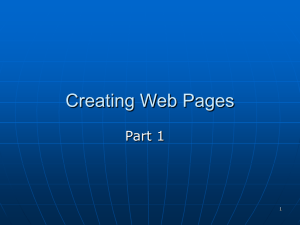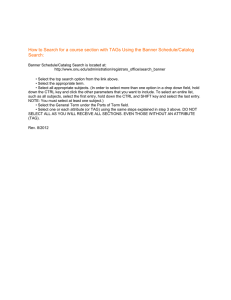Slides of module 4:HTML
advertisement

Designing for Use CS 105 Building Blocks of the Web • HTML – The language of the web. Every web developer should have a basic understanding of it. • XHTML – Extensible Hyper-Text Markup Language, a reformulation of HTML in XML. • XML and XSL – XML is a language for describing data. – XSL is a language for transforming data (to customize view of data). • Managing Data with SQL User Interface • Aspect of a program or machine that is visible to the user. • UI of a system is part of the system which interacts with the user. • We introduce HTML (Hyper-Text Markup Language) which is used to define WWW pages. Evolution of the UI • First generation: Very first UI was wires and plugs (ENIAC) • Second generation: Computers had operators. Programmers stored their programs and the input on punch cards or paper tapes. Then they would carry the set of cards to operator and asked him to run the program. The operator would return the printed output. • Third generation: With emergence of time sharing computers, a computer would be connected to several terminals. Each terminal was a device like a typewriter (input) and a roll of paper (output) • Fourth generation: The video display terminals replaced the roll of paper with a video screen. (Command-line UI) • Fifth generation: The advent of Bitmapped screens (displays with pixel-by-pixel control as opposed to line-by-line or character-bycharacter control) and mouse led to introduction of Graphical User Interface (UI we are using today. It contains menus, buttons, frames,…) . Guidelines for System design • A system should be transparent. The user should be able to use it without having to master the entire user manual of the system. • A system should be forgiving, so that there is usually a way to avoid or recover from potentially disastrous actions. ( Recovery: ability to return to a previous state after taking one or more actions). • A system should be visually oriented. Who is making the Web standards • The Web standards are not made up by Netscape or Microsoft. • The rule-making body of the Web is the W3C • W3C stands for the World Wide Web Consortium. • W3C puts together specifications for Web standards. • The most essential Web standards are HTML (hypertext markup language), CSS (cascading style sheets) and XML (extensible markup language). Level of Abstraction • In introducing a complex subject as Computer Science it is important to concentrate on big picture first to avoid being bogged down by details. • At this point we are not concerned about how a browser interprets html documents or how bold text is displayed on sceen. • But, we concentrate on how to use html to design a web page. HTML • Provides a simple notation for describing nearly all of the features we would want to incorporate into design of our page. • Hyper-Text Markup Language - Hyper : Links - Text - Markup : Tags to describe the page we are designing. - Language : It is a computer language with its syntax and semantics. What is an HTML file • An HTML file is a text file containing small markup tags. • The markup tags tell the web browser how to display the page. • These tags are called Elements. • An HTML file must have an htm or html file extension. • An HTML file can be created using a simple text editor HTML Elements • HTML Tags – – – – Tags are used to mark-up HTML elements. Tags are surrounded by “<“ and “>” (angle brackets). Tags normally come in pairs like <html> and </html> Start and end tags mark off regions of the text file to indicate some processing that is to be applied to that section of text. This region is called the content of the element. – There are elements like <BR>, which do not mark blocks of text and thus do not require and end tag. – Tags are not case sensitive, <b> is the same as <B> HTML Elements • Tag Attributes – Tags can have attributes to provide additional information about the HTML elements on your page. – <BODY BGCOLOR=“Red”> … </BODY> will show a red background. – Attributes are always added to the start tag of an HTML element. HTML Elements • Headings – Headings are defined with the <H1> to <H6> tags. <H1> defines the largest heading. <H6> defines the smallest heading. • Paragraphs – Paragraphs are defined with the <P> tag. • Line Breaks – <BR> tag is used when you want to end a line, but you don’t want to start a new paragraph. • Horizontal Rule: <HR> • Comments in HTML – <!-- This is a comment --> is a comment and it will be ignored by the browser (Notes for programmers). Page Structure • HTML elements control the details of how a page gets displayed. • Every HTML document has the following basic structure: <HTML> <HEAD> … </HEAD> <BODY> … </BODY> </HTML> Page Structure • The HTML element surrounds the entire page description and identifies it to the browser as an HTML document. • The HEAD element contains relatively few elements that provide the browser information about the document. • The BODY element contains all of the text to be displayed and elements that control its display on the page. Try HTML • Open Notepad or Wordpad. • Type: <html> <head> <title>Title of Page</title> </head> <body> This is my first homepage. <b>This text is bold</b> </body> </html> • Save the file as “mypage.html” • Close the Notepad and find the file from local drive, you can see this file has the webpage icon, double click the file and see it through Internet Explorer. HTML Links • HTML uses a hyperlink to link to another document on the web. • HTML uses the <a>(anchor) tag to create a link to another document – An anchor can point to any resource on the Web: an HTML page, an image, a sound file, a movie, etc. – The href attribute is used to address the document to link to • Ex: <a href=“www.cs.umb.edu”> CS Dept.</a> HTML Links • The name attribute is used to create a named anchor. When using named anchors we can create links that can jump directly into a specific section on a page, instead of letting the user scroll around to find that section. – Ex. <a name=“Tips”> Tips to display</a> And we can have a link to jump to Tips section: <a href=“#Tips”>Go to Tips </a>. HTML Images • An image element doesn’t contain anything and has no close tag. <IMG SRC = “ Some URL” (Required) Where the image is. ALIGN = LEFT, RIGHT, or CENTER How to align it on the page. WIDTH = n Scale the image to n pixels wide. HEIGHT = n Scale the image to n pixels high. HSPACE = n Total space around the image horizontally. VSPACE = n Total space around the image vertically. ALT = “some text”> What shows up if the image doesn’t appear. HTML Images • The IMG element is an element that uses its attributes to identify an image to be inserted into the page and to describe how the image is to be presented. • Images are identified using the required SRC attribute, the value of which is a URL. • Images don’t really live in the pages they appear in, but they are treated as implicit hyperlinks to the specified file. • The image may be aligned relative to the text it appears next to using the ALIGN attribute. • The size of the image can be controlled using the WIDTH and HEIGHT attributes. • The HSPACE and VSPACE attributes indicate the total number of pixels of space that will surround the image. • The ALT attribute should be used to provide a text substitute for non-graphical browsers and also for use while the image is loading. HTML Tables • In HTML, tables are defined with the <TABLE> tag. • A table is divided into rows (with the <TR> tag, and each row is divided into data cells (with the <TD> tag). The letters TD stands for “table data” which is the content of a data cell. • A data cell can contain text, images, lists, paragraphs, forms, horizontal rules, tables, etc. Tables and Border • If you do not specify a border attribute, the table will be displayed without any borders • To display the table with borders, you will have to use the border attribute – Ex. <table border=“1”> Table and Heading • Headings in a table is defined with <th> tag. • Ex. <th>Column 1</th> HTML Tables <TABLE BORDER = n CELLSPACING = n CELLPADDING = n WIDTH = n or n% Width of the table border. Space between cells. Blank space within cells. Width of the table in pixels or as a portion of the page. A table can only contain TR elements. </TABLE> HTML Tables <TR ALIGN = “LEFT”, “RIGHT”, or “CENTER” Alignment of contents of data in cells. VALIGN = “TOP”, “BOTTOM”, or “MIDDLE”> Vertical alignment in cells. A table row can only contain TD or TH elements. </TR> HTML Tables <TH ALIGN = “LEFT”, “RIGHT” or “CENTER” Alignment of contents in this cell. VALIGN = “TOP”, “BOTTOM” or “MIDDLE” Vertical alignment in this cell. COLSPAN = n Width, in columns of this cell. ROWSPAN = n Height, in rows, of this cell. A table header can contain text, images, links, lists, and tables. </TH> HTML Tables <TD ALIGN = “LEFT”, “RIGHT” or “CENTER” Alignment of contents in this cell. VALIGN = “TOP”, “BOTTOM” or “MIDDLE” Vertical alignment in this cell. COLSPAN = n Width, in columns, of this cell. ROWSPAN = n> Height, in rows, of this cell. A table data cell can contain text, images, links lists and tables. </TD> HTML Lists • Unordered lists: a list of items marked with bullets – <ul> <li> Dogs </li> <li> Cats </li> </ul> • Ordered lists: a list of items marked with numbers – <ol> <li> Fish </li> <li> Duck </li> <ol> HTML Lists • A definition list is a list of terms and explanation of the terms. – <DL> <DT>Coffee </DT> <DD>Black hot drink </DD> <DT> Milk </DT> <DD> White cold drink </DD> </DL> HTML Lists <OL TYPE = “A”, “a”, “I”, “i”, or “1” Type of label for items START = n> Starting value for labels <LI> … <LI> … </OL> An ordered list can only contain LI elements. HTML Lists <UL TYPE = “DISC”, “CIRCLE” or “SQUARE”> Type of label for items. <LI> … <LI> … </UL> An unordered list can only contain LI elements. HTML Lists <LI TYPE = “DISC”, “CIRCLE”, or “SQUARE” (In UL) Type of label for this and later items. TYPE = “A”, “a”, “I”, “i”, or “1” (In OL) Type of label for this and later items. VALUE = n> (In OL) Label value. A list item can contain text, lists, images, tables and links. A list item doesn’t require a close tag, though it’s not a bad idea to put one in anyway. HTML Frames • With frames, you can display more than one HTML document in the same browser window. Each HTML document is called a frame, and each frame is independent of the others • The Frameset tag – <frameset cols=“25%, 75%”> <frame src=“frame_a.html”> <frame src=“frame_b.html”> </frameset> • The example shows a frameset with two columns. The first column is set to 25% of the width of the browser window, and the second is set to 75% width of the browser window. HTML Frames <FRAMESET ROWS = n, n, … or n%, n%,… Height of the frames in pixels or as a portion of the page. COLS = n, n, … or n%, n%, … Width of the frames in pixels or as a portion of the page. BORDER = n Space, in pixels, between frames BORDERCOLOR = “color” Color of the border between frames. FRAMEBORDER = “yes” or “no” > </FRAMESET> HTML Frames <FRAME SRC = “some url” (Required) URL of the HTML document that will appear in this frame. MARGINWIDTH = n Blank pixels to be used to left and right of this frame’s contents. MARGINHEIGHT = n Blank pixels to be used to top and bottom of this frame’s contents. SCROLLING = “yes”, “no” or “auto” NORESIZE BORDERCOLOR = “color” FRAMEBORDER = “yes” or “no” </FRAME> HTML Background • The <Body> tag has two attributes where you can specify backgrounds. The background can be a color or an image. • The BGCOLOR attribute sets the background to a color. The value of this attribute can be a hexadecimal number, an RGB value, or one of the 16 predefined color names. – <body bgcolor=“#000000”> – <body bgcolor=“rgb(0, 0, 0)” – <body bgcolor=“black”> #00 00 00 three two digits hexadecimal numbers (base 16) ranging from 0 to 255 (00 to FF). The first number specifies the intensity of red, second green and third blue. Example: #000000 #FFFFFF #800080 (violet) HTML Background • The background attribute sets the background to an image. – <body background=“yourimage.gif”> – <body background=“http://website.com/image.gif”> A good HTML tutorial is available at: http://www.w3schools.com/html/




